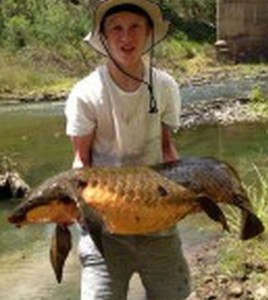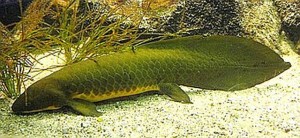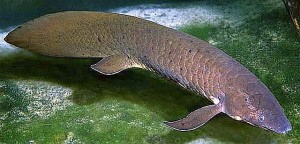The Queensland Lungfish (Neoceratodus forsteri) is the sole surviving member of the family Ceratodontidae and is known to tropical fish keeping enthusiasts as the Australian lungfish, Barramunda, or Burnett Salmon.
The Queensland lungfish is truly a “living fossil” and one of only six species remaining in modern times. Of the six known surviving members of ancient air breathing lungfishes (Dipnoi) that flourished during the Devonian period (about 413–365 million years ago), it is the most primitive.
Like all lungfish, the Queensland lungfish has the ability to “breathe” out of water for extended periods however, unlike their African and South American cousins, it has gills and their skin must be kept moist to survive. South American and African lungfish lack gills and can survive their annual dry seasons by secreting a mucous cocoon around their bodies and burying themselves in the mud.
The five other freshwater lungfish species are very different morphologically from Neoceratodus forsteri in that they have two lungs.
Queensland lungfish have only one dorsal lung that is actually a modified swim bladder used to supplement the oxygen supply through their gills during periods of drought or high temperatures when the waters become deoxygenated. During these conditions, the lungfish can rise to the surface to gulp air into it’s lung.
Although the Queensland lungfish is native only to the Mary and Burnett River systems in south eastern Queensland; they have been successfully introduced into the Brisbane, Albert, Stanley, Pine, Caboolture, Condamine, and Coomera Rivers, as well as the Enoggera Reservoir.
Queensland lungfish live in the still, slow moving waters of rivers and reservoirs that have some aquatic vegetation present. They can be found in small groups under submerged logs, caves formed by the erosion of substrate from tree roots along river banks, or in dense banks of aquatic macrophytes.
They frequent slow moving pools that are anywhere from 10 to 35 feet deep, and are equally comfortable over mud, sandy, or gravel bottoms.
Although the Queensland lungfish is tolerant of the cold, it prefers water temperatures between 59 and 78 degrees F.
Queensland Lungfish are a sedentary species that spend their entire lives in a relatively restricted area. Their home territories seldom extend beyond a single deep pool or two adjacent pools, and except from July through December when they may seek out suitable spawning areas, they do not follow any set migratory paths. Although they are sluggish and inactive, they are capable of rapid movement with a flick of their strong tail. They are a nocturnal species that is usually more active during the late afternoon and evening hours than during the day.
Queensland lungfish are colored an olive green to a dull brown on the back, sides, tail, and fins, and a pale yellow to orange on the underside. Males have a reddish color along their sides that becomes much brighter during the breeding season and is the only distinguishing sexual characteristic of the species.
Queensland lungfish are the largest of all the known species of lungfish. They have elongated bodies, flattened heads with small beady eyes, and small mouths that are positioned low on their heads.
They are slow growers that commonly reach lengths of almost 5 feet and weigh in at close to 100 pounds. On average they weigh around 20 pounds and are a little over 3 feet in length with females being slightly larger.
The bodies of Queensland Lungfish are slimy and covered with large bony scales. They have large, long, powerful tails; fleshy, flipper like pectoral fins, and fleshy, flipper like pelvic fins that are situated far back on the body. Their dorsal fins begin in the middle of the back and merge with the caudal and anal fins.
The scales of these fish overlap extensively and are embedded in their own pockets to protect vulnerable body areas of the fish that are covered by a thickness of at least four scales. Their heads are also covered by very large, thick, interlocking scales that protect their thin bony skull.
The skeleton of the lungfish is partly cartilage and partly bone. Their vertebrae are pure cartilage, but their ribs are hollow tubes filled with a cartilaginous substance. They also have unusual teeth. Two flat, slightly bent incisors are on the upper jaw with dental plates on the upper and lower jaws.
Juvenile Queensland lungfish are mottled with a base color of olive brown or gold. As they age, the mottling disappears but dark patches still remain. Juveniles are also able to change colors rapidly in response to different lighting conditions. This trait disappears as their colors become denser.
Juveniles also have different body proportions than mature adults. Their heads are rounder, the fins are smaller, and the body is more slender. Their mouth is located at the front of their head but shifts back as the fish grows and their dorsal fin begins at the back of the head but gradually moves to the center of their back as they mature.
The Queensland lungfish spawn and live their entire lives in freshwater. Males are capable of spawning at 17 years of age and females at 22 years. They spawn in pairs from August to December before the spring rains, and reportedly go through an elaborate courtship. Spawning activity is believed to be stimulated by the length of the day and they will spawn during daylight or at night.
Their eggs are deposited on aquatic plants in flowing streams that are at least three feet deep and immediately fertilized by the males. They do not make a nest, guard their eggs, or exhibit any parental care for their young. They are selective of their spawning sites and although their eggs have been observed on aquatic plants that are rooted in sand and gravel in fast moving waters, in full sun and in the shade; they will never deposit their eggs on plants that are covered with slimy algae, in stagnant water, or in water with floating debris on the surface.
The sticky eggs are hemispherical in shape, enclosed in a triple jelly envelope, and are about .39″ in size. They are deposited by the female singly or sometimes in pairs but never in large clusters and the “stickiness” disappears shortly after the egg is attached to an underwater plant.
A female Queensland lungfish has the capacity to lay several hundred eggs but they seldom produce more than a few hundred during their lifetimes. They do not spawn every year but have cycles that seem to peak every five years or so, regardless of environmental conditions. The eggs resemble those of a frogs eggs and hatch out after 3 to 4 weeks. The young look like little tadpoles and are extremely slow growing. They do not eat for 2 to 3 weeks until their egg sacs are absorbed. By the time their egg sacs are absorbed, the fry develop a spiral valve in the intestine which allows them to feed. After 100 days or so, they will be about 1″ in length, and at 8 months, only 2 1/2″ long. Under optimal conditions, their growth rate is only about 2 inches a month.
Adult Queensland lungfish have a high survival rate and are extremely long lived. They usually live to at least 20 or 30 years in their natural habitat but a specimen in the Shedd Aquarium in Chicago nicknamed “Granddad”, is at least 80 years old and has been there since 1933.
The Queensland lungfish is carnivorous and in the wild, its prey includes frogs, tadpoles, fishes, crayfish, crabs, a variety of invertebrates, and plant material.
Juveniles and lungfish larvae are bottom feeders and will eat small Tubifex worms, small crustaceans, earthworms, and filamentous algae. As they grow into adulthood in captivity, they will feed on frogs, earthworms, shrimp, pieces of meat, and pelleted food.
The Australian lungfish is currently CITES protected but occasionally available to the trade through licensed breeders. They are usually quite expensive ($700.00 or more) for a single specimen and considerably more for albino specimens.
Minimum Tank Size: 100 gallons
Care Level: Difficult
Temperament: Aggressive
Aquarium Hardiness: Extremely Hardy
Water Conditions: 59-79° F, KH 1-12, pH 6.0-7.5
Max. Size: 5′
Color Form: Gold, Olive Green
Diet: Carnivore
Compatibility: Single Species Only
Origin: Central Africa Family: Polypteridae
Lifespan: Up to 80 Years
Aquarist Experience Lever: Intermediate





One Response to “Queensland Lungfish (Neoceratodus forsteri)”
Trackbacks/Pingbacks
[…] Queensland lungfish Neoceratodus forsteri […]